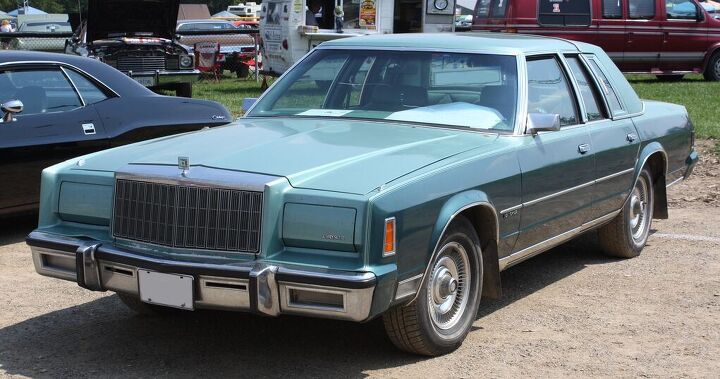The Perfect Chrysler Metaphor, Intentional or Not

It was a dark and unexciting night. The setting: my apartment. The time: well, last night.
The hour was was growing late, but going to bed at a normal time on a Friday night — even my definition of a normal time — seemed like an invitation to early onset senility. I’m a human being, dammit, I’m alive, and doing anything — anything — besides refreshing my taxed brain cells seemed like a good plan.
So, a Budweiser was cracked, an old movie was sought out, and my feet soon raised themselves to a comfortable, elevated position. Now, many who aren’t familiar with my history are unaware of a shocking secret — something that could prompt fits of laughter if you’re not ready for the news.
I minored in film studies in university. Hey, those were elective courses, and I paid for them through hard work. A student needs some classroom entertainment amid the tedious statistics and communication courses and all the drudgery that comes with pursuing a bachelor’s degree.
Being Canada, it was an oh-so-liberal education. Ever watched Deep Throat in a mixed-gender classroom? We did. I’m forever grateful for a terrific professor who told me to never look for sex in a movie — you’ll always find it. It’s true, and the snobbiest film critics always uncover the smut swirling in their own minds.
But back to last night. The movie was Blow Out, a 1981 thriller directed by the stylish Brian De Palma (Carrie, Scarface, The Untouchables). There’s a simple plot. A soundman with great hair (John Travolta) accidentally records the sounds of a car careening off a low bridge after supposedly suffering a tire blowout. But things aren’t exactly what they seem, as movies need audiences and a minimum 90 minute run time.
Watching this, my past “education” suddenly came barreling back.
You see, the car in question holds particular significance for that era in American history. It’s symbolic of so many things. The vehicle crashing through the guardrail and into a river was an R-body Chrysler — a white New Yorker, to be exact. Hidden headlights, landau roof, whitewalls and all. A beautiful failure that launched out of desperation in 1979 and met a swift end in 1981.
I won’t bore you with the backstory of the R-bodies — Chrysler’s hasty and penniless campaign to shed weight and market a “new” full-sizer in an age of downsizing — but it’s a story that has always fascinated me.
It struck me that the car in this film was Chrysler Corporation, or at least the Chrysler Corp. of that era. The second gas crisis, skyrocketing pump prices and a stagnant economy meant that the uber-popular luxo-barges of the Seventies were persona non grata at the onset of the Eighties. Chrysler’s financial woes and archaic platforms meant even less interest in new land yachts from the Land of Pentastar.
At the time of Blow Out’s filming — sometime in 1980 — Chrysler was on government life support. The once sought-after status symbol was sinking fast, not unlike the New Yorker in the film, and the Chrysler Corporation Loan Guarantee Act of 1979, signed into law in early 1980, had yet to bear the company fruit. (It would, and very soon, but few people at the time could predict the company’s sudden early-80s turnaround.)
The film, I should point out, takes place in Philadelphia. The occupant of the sinking New Yorker? The state’s governor. Let’s just say that it was his last turn behind the wheel. You know who else is from Pennsylvania? Former Chrysler CEO Lee Iacocca.
At the time of filming, the outdated product rolling out of Chrysler plants threatened to doom the company, and Iacocca’s career, to an early grave. The film’s metaphor might not have been intentional, but it works brilliantly on several levels, whether you choose to see Iacocca or the federal government behind the wheel. For the career aspect, the metaphor obviously works better if you picture Jimmy Carter as the occupant of that velour and faux wood-festooned sedan.
Was Brian De Palma really concerned with the plight of Chrysler Corporation, so much so that he just had to insert the loaded images into his film? Probably not. Still, he deserves kudos for his work, and for this little bit of distraction.
Maybe I think too much late at night.
[Image: Wikimedia Commons ( CC BY-SA 3.0)]

More by Steph Willems
Latest Car Reviews
Read moreLatest Product Reviews
Read moreRecent Comments
- AZFelix I have always wondered if the poor ability of Tesla cars in detecting children was due to their using camera only systems. Optical geometry explains that a child half the height of an adult seems to have the same height as that same adult standing twice as far away from the viewer.
- 28-Cars-Later Actually pretty appealing (apparently I'm doing this now). On a similar note, a friend of mine had a difficult situation with a tenant which led to eviction and apparently the tenant has abandoned a 2007 Jag S-Type with unknown miles in the garage so he called me for an opinion. Before checking I said $2-3 max, low and behold I'm just that good with the 3.0L clocking in at $2,3 on average (oddly the 4.2 V8 version only pulls $2,9ish) and S-Types after MY05 are supposedly decent.
- DO I have owned a 2012 LR4 since day one and it has been the best vehicle I have ever had the pleasure of having in the garage. I know how easy it is to hate on Land Rover but this LR4 is comfortable, has a ton of storage room and is so versatile. With 110k miles, mine is now relegated to ‘other’ car use but is still the go to for off road adventures and snow runs. Nice to see one featured here - I think they are so underrated.
- Tane94 I'd be curious to know whether 87 octane is no longer the most popular grade of gasoline by sales volume. My Costco often runs out of Premium grade and I suspect 93 octane might now be the most popular grade of gas. Paying 40-50 cents more per gallon 87 vs 93 octane because of turbo engines is the real story
- Redapple2 125 large? You re getting into 911 territory.



































Comments
Join the conversation
Ever since my parents looked at a 1981 New Yorker Fifth Avenue, I have always liked these cars. I love the hidden headlights, frameless doors, and landau top. I could never understand why these weren't manufactured longer. They had clean lines and were comfortable. Switching to the former Le Baron platform was not the greatest move. Hopefully these are collectibles. Especially the '81 Fifth Avenue in mink brown, with the stainless steel top. Talk about rare!
Before it went into the River, was the passenger - of British and French heritage - shoved out of the car and scooped up by a passing Peugeot and later change their name to 'Talbot'?